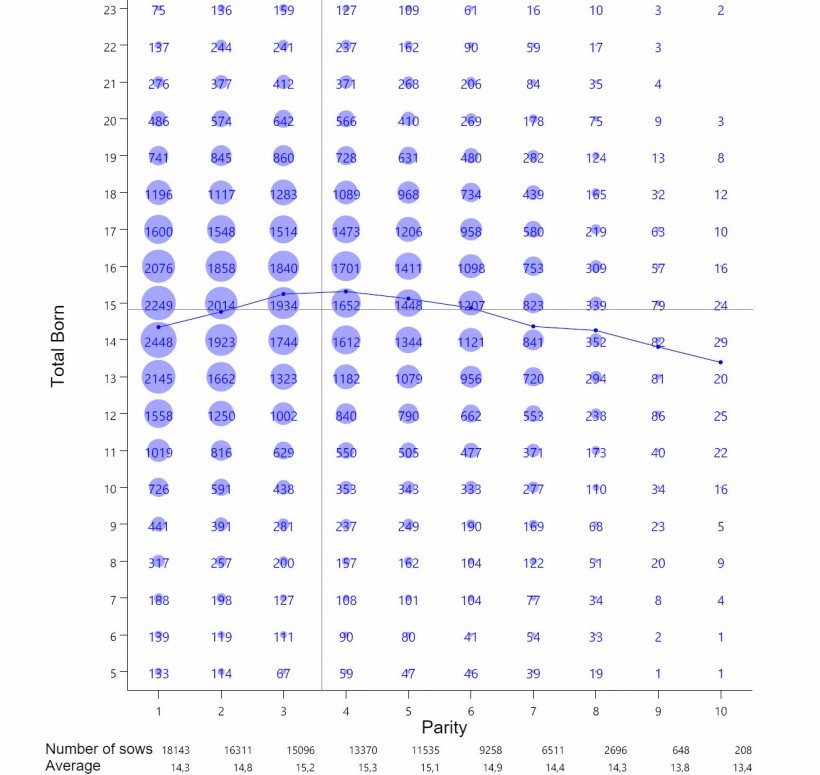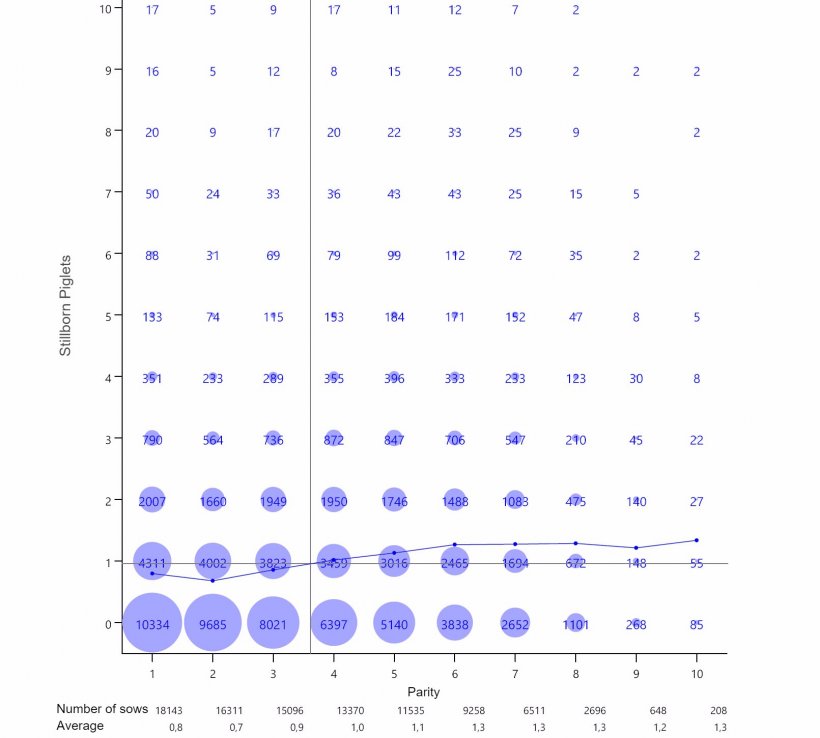Genetic improvement in pig farming poses a challenge for producers, veterinarians, and farm workers, since it is necessary to make the most of the main advantage of hyperprolific sows, greater prolificacy, to produce as many good quality piglets as possible per sow.
One of the challenges with hyperprolific sows is that larger litter sizes influence the number of stillborn piglets, but do we know to what extent? This article explores how sows’ prolificacy affects the number of stillborn piglets.

Two years of farrowings (October 2014 – September 2016) of a group of farms from the PigCHAMP Pro Europa SL database, adding up to 20,160 productive sows and working with different hyperprolific genetics, were analysed. That made a total of 93,896 farrowings, with an average 3.6 farrowings per sow.
The average total born (TB) in these litters was 14.8 piglets, with the highest performance in parities 3rd and 4th (15.2 and 15.3 TB respectively.)

Graph 1: Average Piglet Total Born per parity. Analysis of 93.896 farrowings from hyperprolific sows recorded from October 14 to September 16
Average stillborn (SB) rate was 1.5 piglets. Sows up to the 4th parity are below 1 SB, and from the 5th parity the number goes up to above 1.

Graph 2: Average stillborn per parity. Analysis of 93.896 farrowings from hyperprolific sows recorded from October 14 to September 16
Next, we analyze if there are differences in the average numbers of stillbirths depending on the number of Total Born. We classified the sows into three groups:
1. Sows with less than 13 TB piglets (21,134 litters)
2. Sows between 13 and 16 TB piglets (43,889 litters)
3. Sows with more than 16 TB piglets (28,873 litters)
The average number of SB in sows farrowing less than 13 TB is 0.5, increasing by 0.2 SB from the 7th parity.
Sows farrowing between 13 and 16 TB have an average 0.8 SB. From the 6th parity, the number of SB increases, exceeding 1 piglet SB per litter.
Finally, in sows with litters with more than 16 TB, the average number of SB is 1.6. Regardless of parity, the number of SB is greater than 1, with a significant increase from the 4th parity, reaching as many as 3 SB in the 10th parity.


Graph 3: Average number of stillborn piglets according to parity for litters of less than 13, between 13 and 16 or more than 16 Total Born piglets. Analysis of 93.896 farrowings from hyperprolific sows recorded from October 14 to September 16

Graph 4: Average piglets Total Born (TB) according to parity for litters of less than 13, between 13 and 16 or more than 16 Total Born piglets. Analysis of 93.896 farrowings from hyperprolific sows recorded from October 14 to September 16
In summary, sows farrowing more than 16 TB have twice as many SB as sows with litters from 13 to 16 TB, and more than three times as many as sows producing less than 13 TB. Evolution in sow genetics increases their prolificacy, but on the other hand, forces us to work in a more professional way in order to be able to take advantage of the full potential of sows.
Management must be very specialized and farm staff must provide excellent care at all stages, from the acclimatisation of replacement gilts, insemination, feeding of sows in all stages, until farrowing, where, if everything has been done correctly, you will see the results. Providing adequate care at farrowing is crucial, and taking into account the clear increase of stillborn piglets from hyperprolific sows mentioned in the article, checking the sow’s record is very important, as well as performing a good farrowing monitoring and ensuring proper care of newborn piglets (drying, colostrum intake...). All this will help reduce numbers of stillborn piglets and improve preweaning mortality. This issue will be discussed in future articles.



